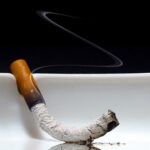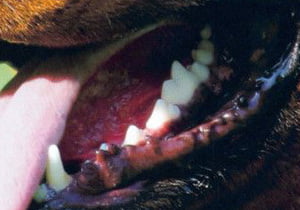The obvious issues of smoking are well known to the public. What most smokers do not realize is that nicotine can seriously stain and destroy your teeth.
Tobacco contains substances that destroy your body’s cells and tissues. Periodontal disease occurs when the soft tissue and bone are destroyed due to bacterial infection. Smokers have more hardened dental plaque than non-smokers. The nicotine in tobacco causes vasoconstriction, or the narrowing of your blood vessels, causing a greater risk for gum disease. Gum disease is caused by a build-up of bacteria in the plaque on teeth when not properly cleaned. The bacteria cause the gums to become inflamed, and then the gums recede from the teeth. The bone that holds the teeth in place gradually becomes destroyed and your teeth become loose. Dentists know that smokers have worse oral and gum disease than non-smokers.
Calculus or plaque hardens on your teeth and can only be removed during a professional cleaning. If the plaque is not removed, it remains below your gum line, and bacteria forms that destroys your gum tissue and causes the gums to pull away from teeth. If untreated, periodontal disease destroys the bone, and your teeth become loose and may fall out. The first sign is bleeding gums, which leads to teeth pulling away from the gums. Tobacco use reduces the delivery of oxygen and nutrients to your gums. Besides tooth loss, periodontal disease is linked to heart disease, stroke, diabetes and respiratory disease.
Smoking leads to discoloration of your teeth. By reducing the flow of saliva that cleanses the lining of the mouth and teeth, teeth become discolored. Nicotine and tar stain the teeth, and the roof of the mouth becomes inflamed. Blood flow to the gums is restricted due to smoking, which causes bad breath leading to loss of teeth. Smoking affects the immune system of the body, making it more difficult for the body to fight off infections.
People who use tobacco products also have greater risk of developing oral cancer, bad breath, stained teeth, tooth loss, bone loss, loss of taste, periodontal disease, mouth sores and facial wrinkling. Tobacco use is harmful to your oral health. Tobacco slows down the healing process and makes periodontal treatment less predictable. The content of the smokeless chewing tobacco is sugar, causing a greater risk of developing cavities. Sugar is a major cause of tooth decay.
How to Improve Oral Care
Quitting tobacco products can greatly reduce health risks, including periodontal disease. Visit a dentist for treatment of gum infection, teeth cleaning and good maintenance of your teeth. Include regular brushing and flossing on a daily basis to prevent dental problems. Use mouthwash, brush and floss twice a day. This will slowly remove nicotine stains and help stop further yellowing of your teeth. Talk to your dentist about whitening strips, which can help whiten teeth and get rid of smoking stains.
Sources:
Smoking and Dental Health: Yellow Teeth, Bad Breath and Other Smoking Effects,” Web MD.
Chewing ‘Spit’ Tobacco (Smoking Cessation),” American Dental Association.
“Study Points to Smoking as Major Cause of Gum Disease,” Perio.org.
“Smokeless Tobacco Facts,” CDC.






